Continuing our look at the top genomic young sires, we now look at the top 10 GPA LPI young sires from Canada. Unlike the US list (Top 10 Genomic TPI Young Sires Review – April 2012) we see a more balanced mix of type and production, as is expected given the differences between the TPI and LPI formulas.
[csv2table source=”https://www.thebullvine.com/wp-content/uploads/2012/04/GLPI-4-12-EBV.csv” icons=”true”]
The following is our analysis of the top 10 GLPI young sires from the April 2012 Genetic Evaluations:
#1 – DE-SU PHOENIX 588
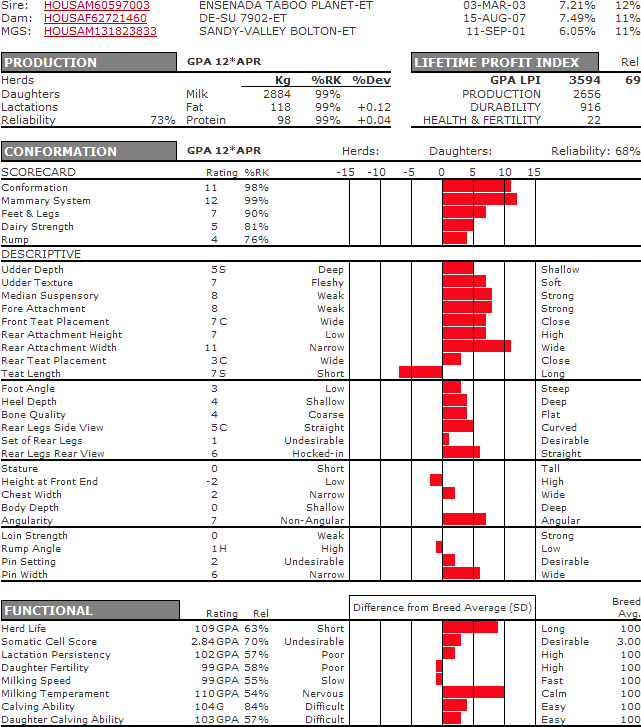
Maintaining his top rank as the #1 GPA LPI young sire in Canada is PHOENIX. From Select Sires, PHOENIX is a Planet from DE-SU 7902 GP-81-2YR-USA DOM, whose dam De-Su Oman 6121 VG-86-2YR-USA DOM GMD has over 20 daughters on the locator list and is the dam of De-Su Observer, the high genomic young sire from Select Sires. PHOENIX combines outstanding production and components with strong conformation. Though a Planet x Bolton cross may raise some concerns about rumps, PHOENIX should inherit his maternal line’s rumps and be ok. The area of strong concern that he does need protected on is his Health and Fertility traits, specifically his daughter fertility and milking speed. PHOENIX will work well on GOLDWYN, SHOTTLE, FEVER, LAUTHORITY, JORDAN blood lines.
#2 – LOOKOUT P ETERNITY
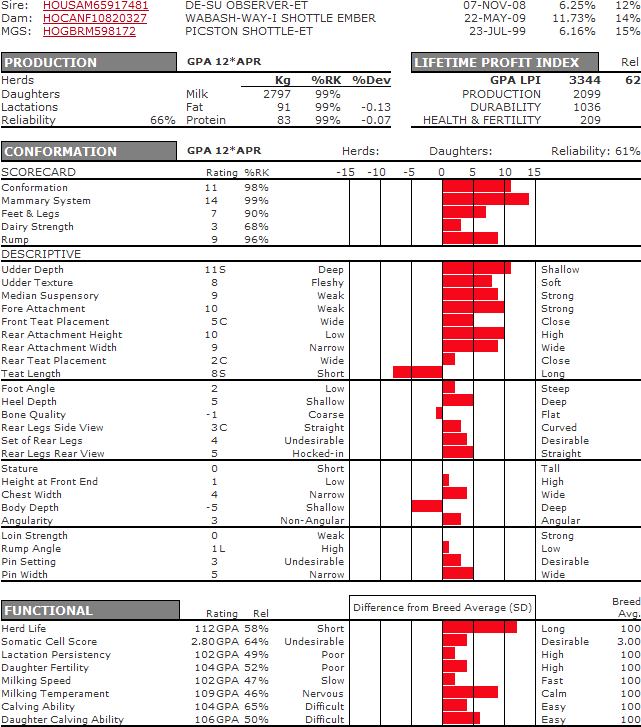
The #2 sire on the list comes from Semex, and WABASH-WAY-I SHOTTLE EMBER VG-85-2YR, who is the Shottle sister to Wabash-Way Emilyann-ET VG-88 DOM who is a former #1 GTPI & CTPI cow of the breed who is the 2nd generation to hold that title as their dam CROCKETT-ACRES ELITA VG-87-4YR-USA DOM 2* was also a list topper. Look for ETERNITY to sire outstanding production though he may be slightly lower on his components than his pedigree would indicate. Much like his young sire father, Observer (Planet x O Man), ETERNITY will transmit the outstanding mammary systems that come from Observer’s maternal line, DE-SU OMAN 6121-ET VG-86-2YR-USA DOM GMD. Also look for ETERNITY to hold true to his sire stack and need protected on Feet & Legs and Dairy Strength though he has a much better Rump, much like his sire. Look for ETERNITY to work well on GOLDWYN, FEVER, JORDAN, LAUTHORITY blood lines.
#3 – CABON FERNAND
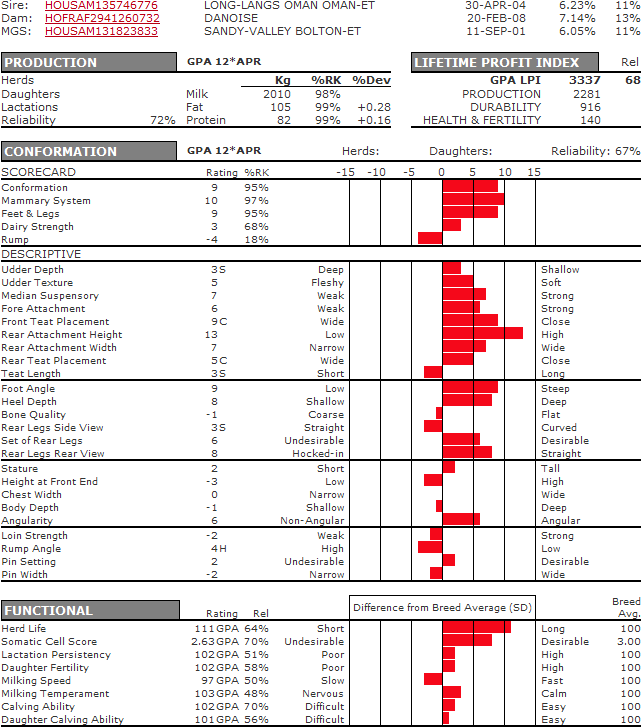
Coming in at #3 is the French bred sire CABON FERNAND. FERNAND’s mother, DANOISE VG-87-3YR-FRA is a fantastic Bolton daughter who stood 3rd in a strong class of Jr. 2yr-olds at the National Show in Le Mans ’11. According to Angelo Pozzatti (Semex), “This is one of the most consistent transmitting cow families in Europe.”, as is evident by the fact that FERNAND’s direct genomic values far out perform his sire stack and parent averages. Watch for FERNAND to sire much more production and components than his pedigree would indicate, with solid conformation, and better feet & legs than expected. However, he will need to be protected on dairy strength and especially rumps. FERNAND will work best on FEVER, LAUTHORITY, MR BURNS, SHOTTLE blood lines.
#4 – SEAGULL-BAY SHAW
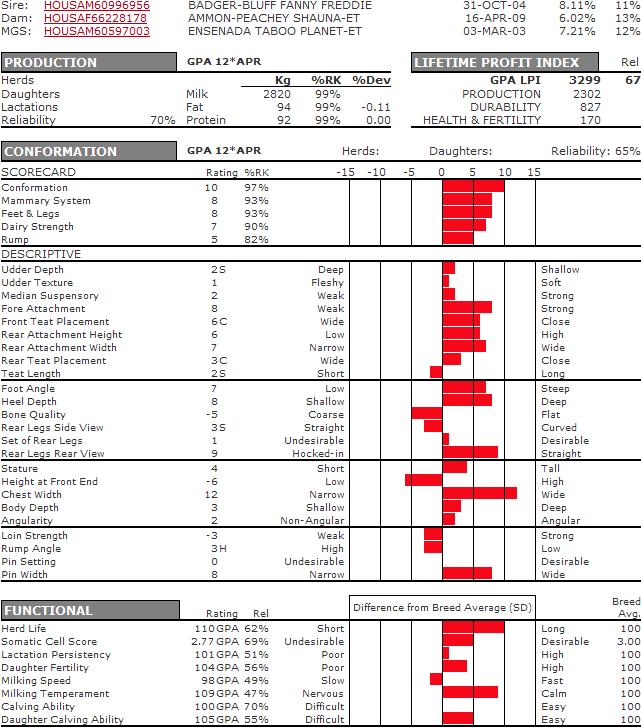
Despite dominating the US GPA TPI list, Selects top Canadian GLPI sire comes in at number 4. SHAW is the Freddie brother to US chart toppers Supersire and Headliner, from AMMON-PEACHEY SHAUNA VG-87-2YR-USA who is the popular Planet bull dam at Seagull-Bay, tracing back to WESSWOOD-HC RUDY MISSY EX-92-3E USA DOM GMD. As is consistent with the Seagull-Bay breeding program, SHAW has an extremely impressive sire stack (Freddie, Planet, Shottle, O Man) with many of the top sires represented. Watch for SHAW to sire extreme production and component kgs. Similar to his brothers, SHAW will transmit solid conformation and much more dairy strength than his extended pedigree would indicate. SHAW will offer breeders a solid option that can mate well with many top bloodlines.
#5 – GENERVATIONS LEXOR
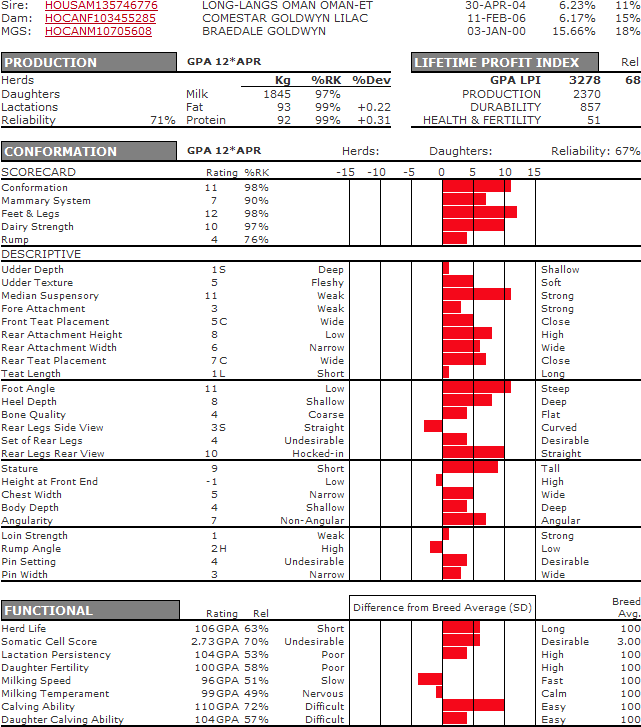
Former #1 LPA-LPI sire LEXOR holds strong at #5 for GenerVations. LEXOR is from the illustrious COMESTAR GOLDWYN LILAC VG-89-5YR-CAN, All-Ontario Sr. 2-YR 2008 and Nom. All-Canadian Sr 2YR 2008 from the legendary 1.15 million dollar cow LYLEHAVEN LILA Z EX-94-CAN 11*. Watch for LEXOR to sire the Canadian Kind, solid components, and balanced production, with better fat and percentage components than his pedigree would indicate. Picking up from his maternal grandsire, Goldwyn, LEXOR will sire much better feet & legs than you would expect as well as greater dairy strength, coming from his maternal side. LEXOR should work well on FEVER, GOLDWYN, JORDAN, LAUTHORITY, SHOTTLE blood lines.
#6 – RUGG-DOC ARTFUL
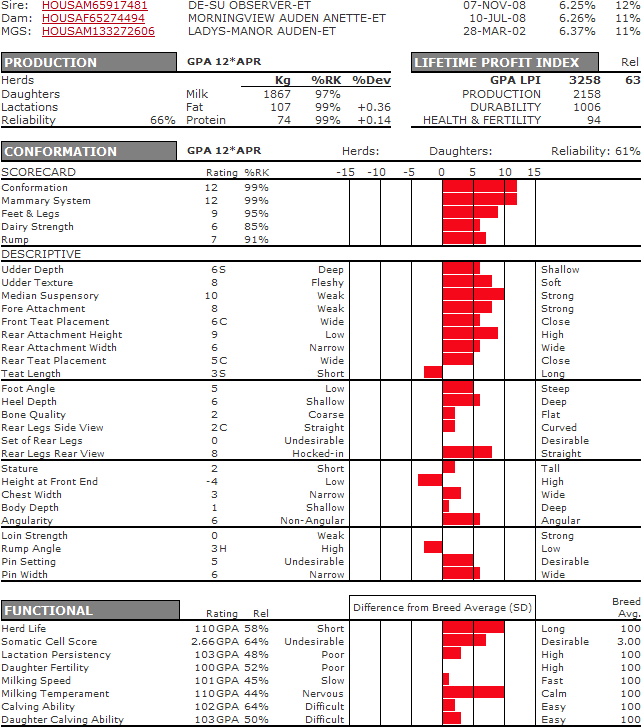
The second OBSERVER son on the list and #6 is ARTFUL. ARTFUL is from the same maternal family as former #3 LPI sire Morningview Ashlar also from SEMEX. Tracing back to the great foundation cows MORNINGVIEW CONVERSE JUDY EX-93-5YR-USA DOM GMD. According to Tom Schmitt, “Judy was 15 years ahead of her time from a health trait standpoint.” This cow family has done extremely well in many different herds all around the world, with Heidenskipster Shottle Silver VG-87-NL-2YR and La Felce Seratta VG-88-IT drawing great attention in Europe. Look for ARTFUL to sire extreme fat improvement with solid production. ARTFUL will also sire the balanced type that is the core of the Semex program. He leaves much greater dairy strength and rumps than his sire stack would indicate, offering the outstanding mammary system improvement that is the staple of his paternal line. Expect him to mate well on PLANET, FEVER, GOLDWYN, JORDAN, BOLTON daughters.
#7 – LEOTHE DEXTERMAN
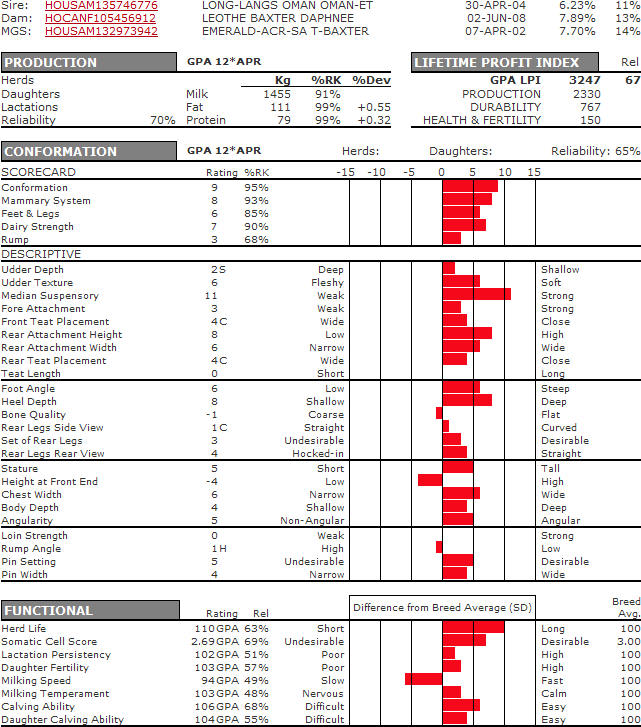
In much the same way that Select Sires dominate the GPA TPI list, Semex is dominating the CDN GLPI list with their third of five sires. DEXTERMAN offers outstanding component improvement though he should be protected on overall production. Not surprising considering his dam LEOTHE BAXTER DAPHNEE VG-86-2YR-CAN just squeezed out 10,799 kgs in a 365-day record. DEXTERMAN’s maternal line shows generation after generation of solid confirmation with average production. Look for DEXTERMAN to offer solid durability and health traits with balanced conformation. DEXTERMAN will fit the bill when looking for extreme component improvement, though considering his sire stack (Man-O-Man x Baxter) he does underperform on the milk side. Look for him to breed much as his maternal line strong conformation, outstanding components, but needs protected on overall production. Watch for DEXTERMAN to mate well on MR BURNS, SHOTTLE, LONGTIME, ALTAALLEGRO, ALADDIN daughters.
#8 – DE-SU 541 BARTLETT
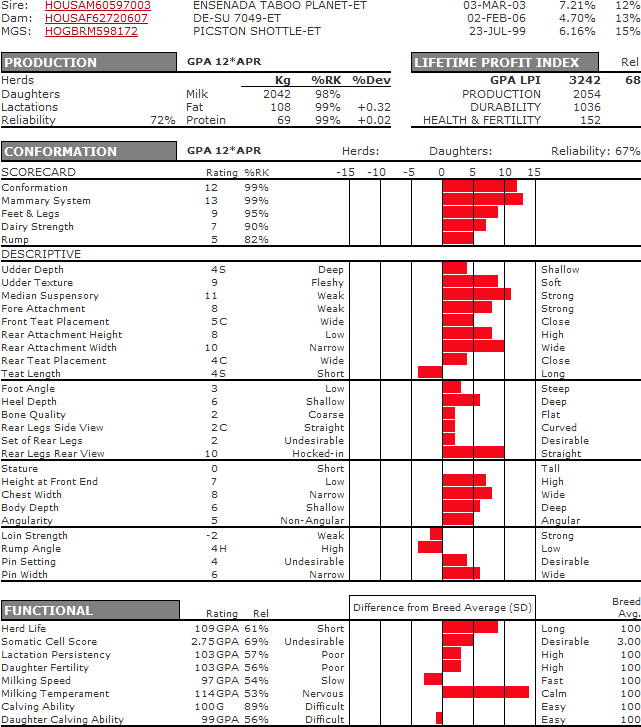
BARLETT’s dam DE-SU 7049-ET VG-85-2YR-USA DOM is a Shottle sister to the popular Planet young sire DE-SU OBSERVER. Progeny from DE-SU OMAN 6121 VG-86-2YR-USA DOM GMD has dominated the top GTPI cow lists. BARTLETT, Select’s 3rd sire on the list, to offer a very balanced package, with much greater fat improvement than his pedigree would indicate. Much like his sire, Planet, BARTLETT will sire outstanding mammary system improvement, as well as good feet and legs. However, I would be cautious in looking for him to be a rump improver, as other than Shottle, many of the sires in his pedigree need to be protected in this area. BARLETT should work well on FEVER, GOLDWYN, JORDAN, LAUTHORITY blood lines.
#9 – SULLY HART MERIDIAN
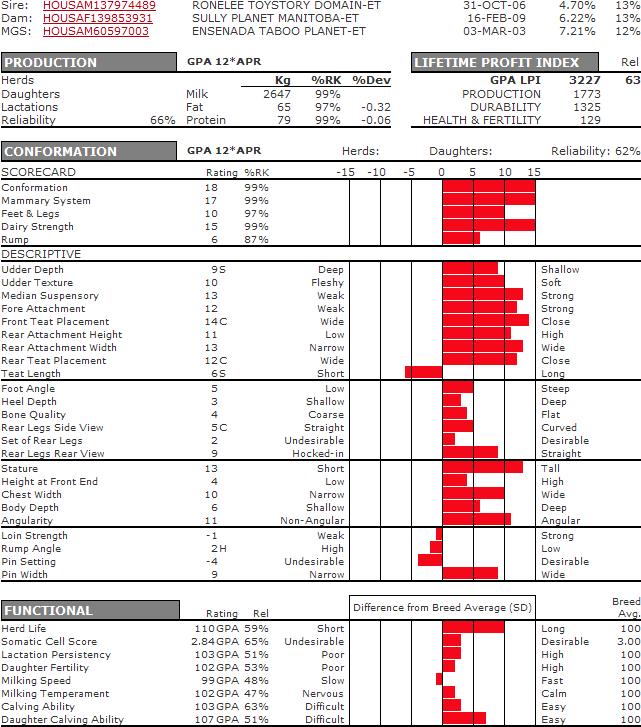
MERIDIAN is another son of a young sire RONELEE TOYSTORY DOMAIN (Toystory x Outside) from Trans-America Genetics. His dam SULLY PLANET MANITOBA GP-83-2YR-USA DOM is a Planet sister to US chart topper MCCUTCHEN from SULLY SHOTTLE MAY VG-85-3YR-USA DOM. May is believed to have more offspring genomic tested over 2200 & 2300 GPTI than any other cow in the breed. Much like the other sires in his family MERIDIAN will sire extreme balance of production and conformation with the potential for breed leading conformation. His direct genomic value (DGV) for conformation is an outstanding 21 and his DGV’s for mammary system (20) and dairy strength (19) are equally impressive. One area to protect MERIDIAN is %F as his DGV’s for % fat is -0.38.
#10 – HFP ALTAQUANTUM
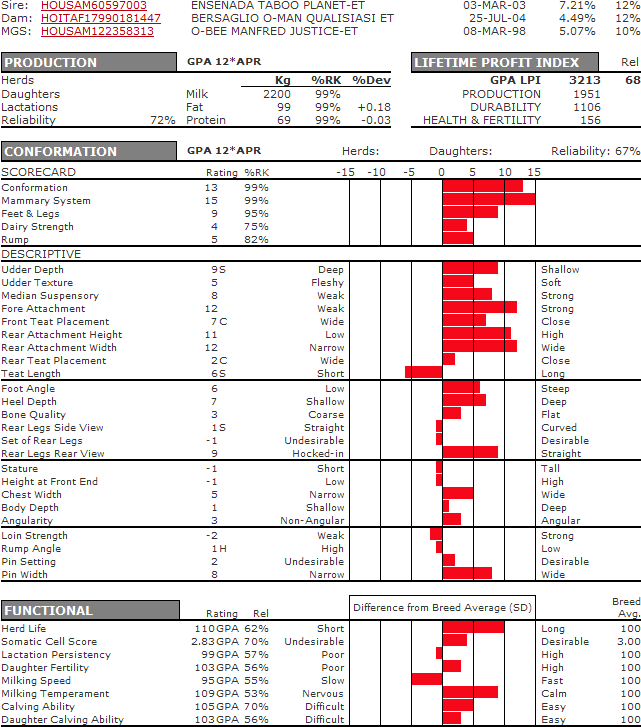
AltaAQUANTUM’s dam, BERSAGLIO O-MAN QUALISIASI VG-87-2YR-ITA is one of the highest contracted dams in Europe and one of the best O Man’s in the world. During her first lactation this well balanced, shallow uddered )-Man daughter scored the maximum score of VG-87 as a 2YR old and produced almost 13,000 kg of milk. Grand dam of AltaQUANTUM is the very fancy BERSAGLIO MTOTO LOCANDA VG-87-3YR-ITA, one of the best and most requested Mtoto daughters in Europe. Next dam is Bersaglio Corsa VG86, a powerful, deep cow sired by Del Santo Corsaro (Aerostar x Chief Mark). The cow family behind AltaQUANTUM has lots of production, health and functional type in the pedigree. Watch for AltaQUANTUM to sire strong production with balanced type. Contrary to what his sire stack would indicate, he will sire strong conformation improvement (DGV of 17 for conformation compared to EBV PA of 7). Also, expect AltaQUANTUM to be a strong mammary system improver with a very similar type-breeding pattern to his sire, Planet, but with a little bit better rumps.
For more information check out The Bullvine Bull Book or our Genetic Evaluation Resource Center.
Other posts you might like:





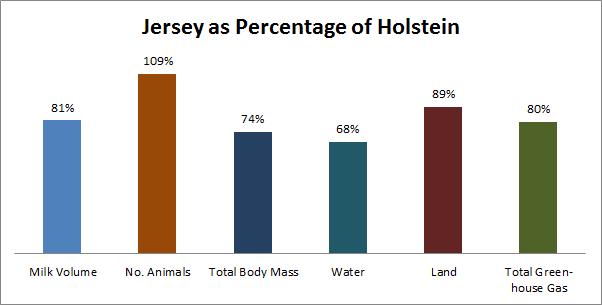


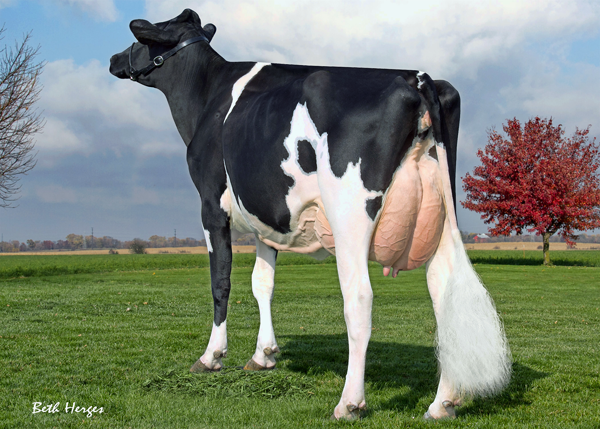
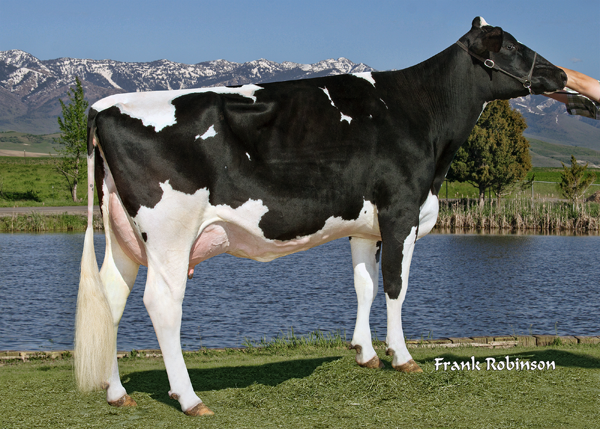
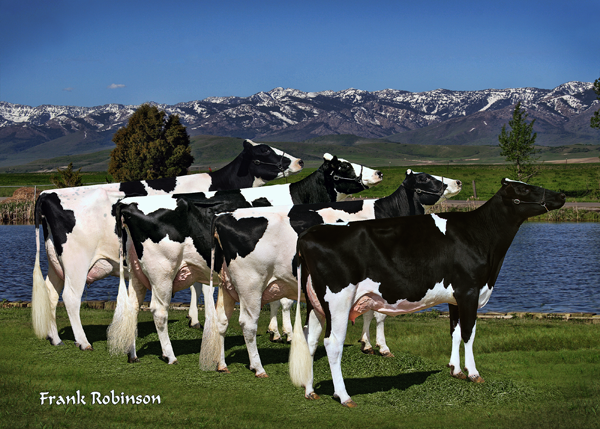
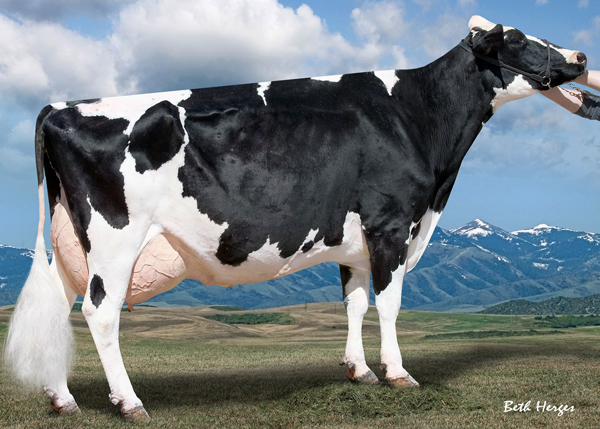










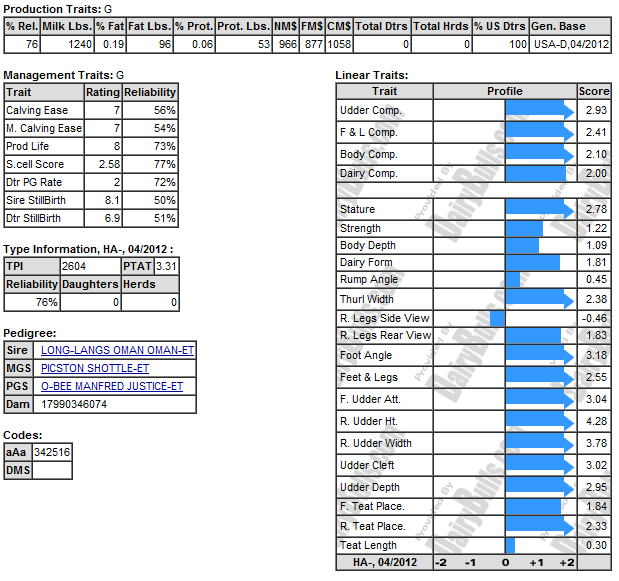
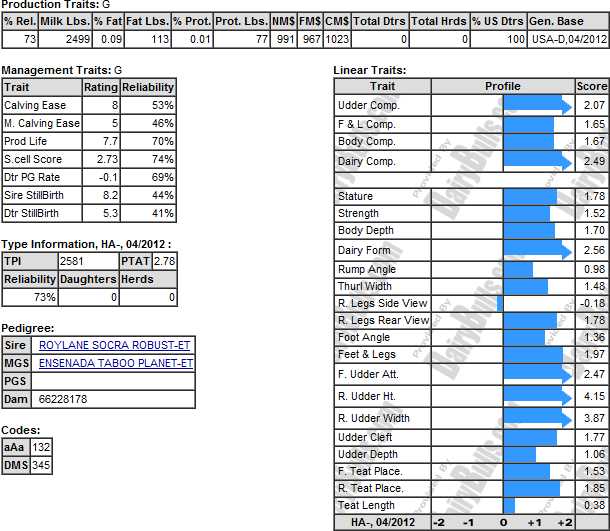
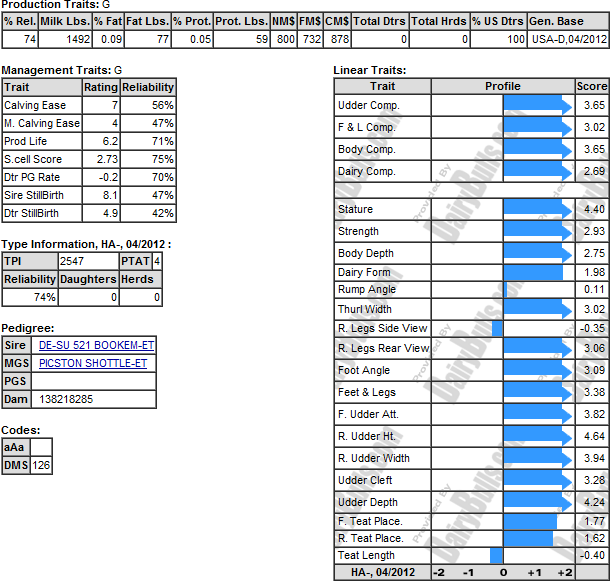
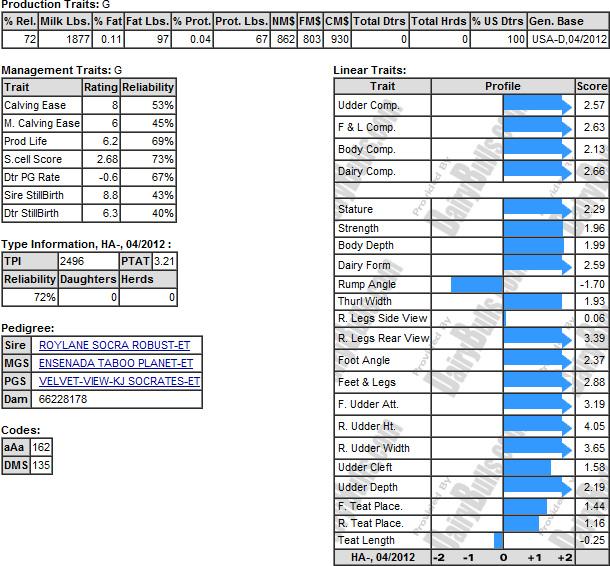
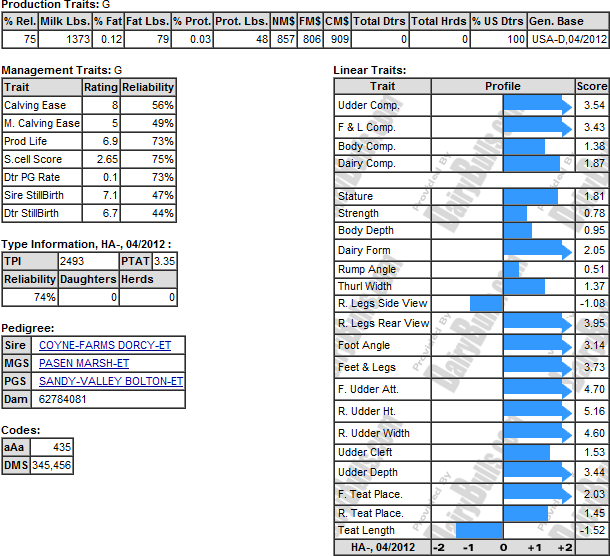

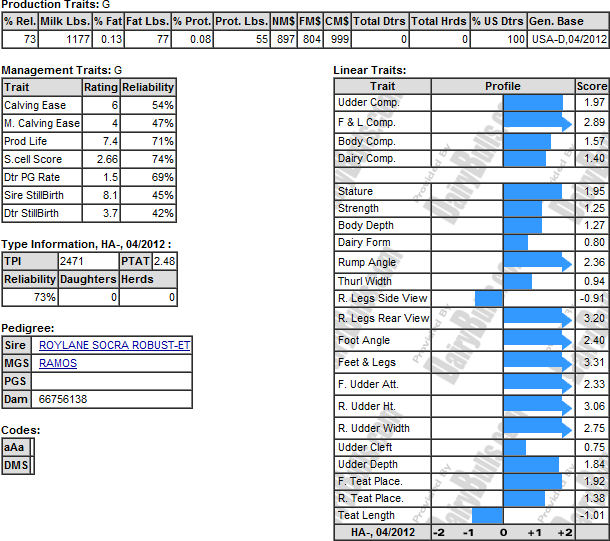

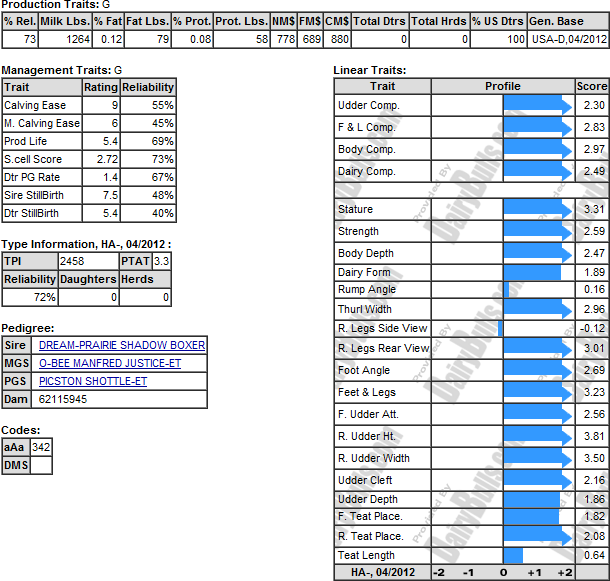
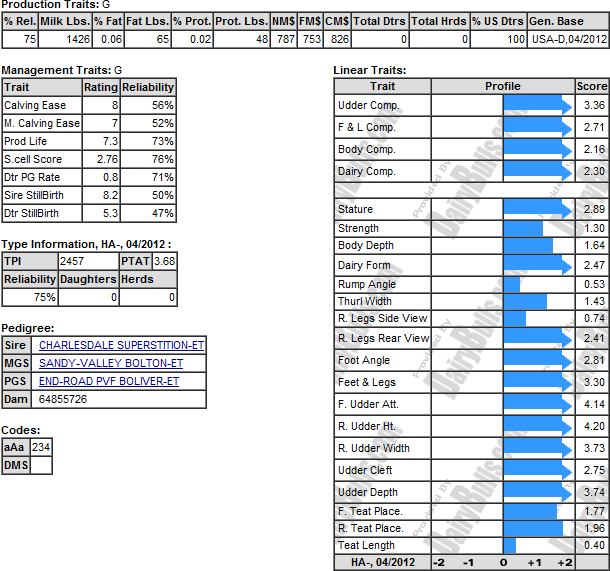
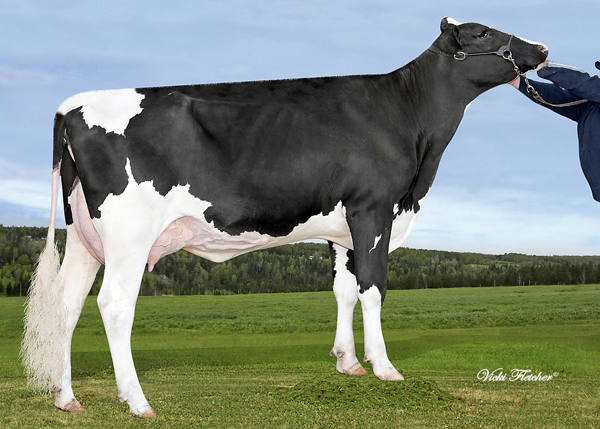
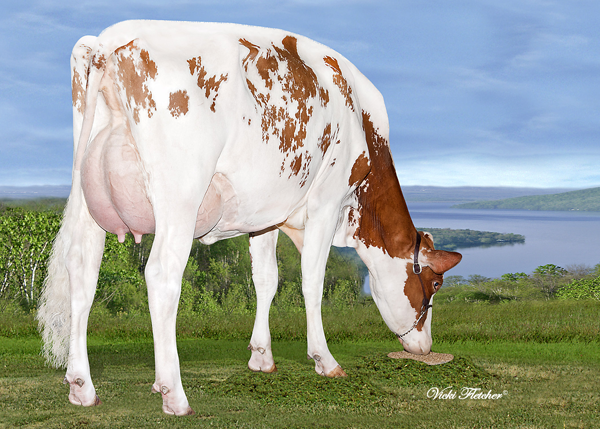
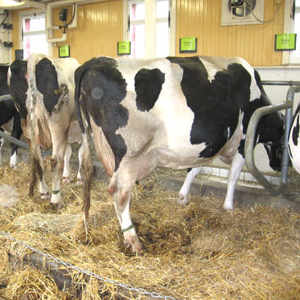 In order to get maximum results from their genetics programs, many top programs needed to have their top cattle score significantly higher than the other animals scored that same day. While many people deemed these herds “Hot Houses”, in reality they are just working the BLUP system to get maximum results. Since the calculations also took into account the genetics of the other animals scored, these “hot house” herds needed to have daughters of high type bulls that would score lower than the selected cattle that were typically sired by bulls with lesser conformation scores. For example, you have a low value cow sired by a +14 conformation sire that goes 79 points, and a high conformation cow sired by a +6 conformation sire that goes 86 points. This would provide the selected cow with the greatest difference over the expected value and have significant improvement in their EBV for conformation and thereby in their overall total merit.
In order to get maximum results from their genetics programs, many top programs needed to have their top cattle score significantly higher than the other animals scored that same day. While many people deemed these herds “Hot Houses”, in reality they are just working the BLUP system to get maximum results. Since the calculations also took into account the genetics of the other animals scored, these “hot house” herds needed to have daughters of high type bulls that would score lower than the selected cattle that were typically sired by bulls with lesser conformation scores. For example, you have a low value cow sired by a +14 conformation sire that goes 79 points, and a high conformation cow sired by a +6 conformation sire that goes 86 points. This would provide the selected cow with the greatest difference over the expected value and have significant improvement in their EBV for conformation and thereby in their overall total merit. With the introduction of genomic evaluations in August 2009, the effects that any “hot house” efforts can have has been reduced in the genetic indexing systems. This is because for young cows in first or second lactation, the relative weighting for Direct Genomic Value (DGV) compared to traditional Estimated Breeding Values (EBV) is roughly 55:45 (
With the introduction of genomic evaluations in August 2009, the effects that any “hot house” efforts can have has been reduced in the genetic indexing systems. This is because for young cows in first or second lactation, the relative weighting for Direct Genomic Value (DGV) compared to traditional Estimated Breeding Values (EBV) is roughly 55:45 (



